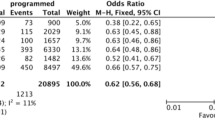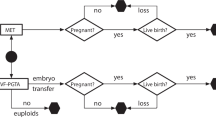Abstract
Purpose
Culturing embryos in groups is a common practice in mammalian embryology. Since the introduction of different microwell dishes, it is possible to identify oocytes or embryos individually. As embryo density (embryo-to-volume ratio) may affect the development and viability of the embryos, the purpose of this study was to assess the effect of different embryo densities on embryo quality.
Methods
Data of 1337 embryos from 228 in vitro fertilization treatment cycles were retrospectively analyzed. Embryos were cultured in a 25 μl microdrop in a microwell group culture dish containing 9 microwells. Three density groups were defined: Group 1 with 2–4 (6.3–12.5 μl/embryo), Group 2 with 5–6 (4.2–5.0 μl/embryo), and Group 3 with 7–9 (2.8–3.6 μl/embryo) embryos.
Results
Proportion of good quality embryos was higher in Group 2 on both days (D2: 18.9 vs. 31.5 vs. 24.7%; p < 0.001; D3: 19.7 vs. 27.1 vs. 21.2%; p = 0.029; Group 1. vs. Group 2. vs. Group 3). Cell number on Day 3 differed between Groups 1 and 2 (6.8 ± 2.2; 7.3 ± 2.1; p = 0.004) and Groups 2 and 3 (7.3 ± 2.1 vs. 7.0 ± 2.0; p = 0.014).
Conclusions
Culturing 5–6 embryos together in a culture volume of 25 μl may benefit embryo quality. As low egg number, position, and distance of the embryos may influence embryo quality, results should be interpreted with caution.


Similar content being viewed by others
References
Reed M (2006) Communication skills of embryos maintained in group culture—the autocrine paracrine debate. Clin Embryol 9:5–19
Wydooghe E, Vandaele L, Heras S, De Sutter P, Deforce D, Peelman L, De Schauwer C, Van Soom A (2015) Autocrine embryotropins revisited: how do embryos communicate with each other in vitro when cultured in groups? Biol Rev 92:505–520
Moessner J, Dodson WC (1995) The quality of human embryo growth is improved when embryos are cultured in groups rather than separately. Fertil Steril 64:1034–1035
Ebner T, Shebl O, Moser M, Mayer RB, Arzt W, Tews G (2010) Group culture of human zygotes is superior to individual culture in terms of blastulation, implantation and life birth. Reprod Biomed Online 21:762–768
Hardarson T, Bungum M, Conaghan J, Meintjes M, Chantilis SJ, Molnar L, Gunnarsson K, Wikland M (2015) Noninferiority, randomized, controlled trial comparing embryo development using media developed for sequential or undisturbed culture in a time-lapse setup. Fertil Steril 104:1452–1459
Vajta G, Peura TT, Holm P, Paldi A, Greve T, Trounson AO, Callesen H (2000) New method for culture of zona-included or zona-free embryos: the Well of the Well (WOW) system. Mol Reprod Dev 55:256–264
Reed ML (2012) Culture systems: embryo density. In: Smith GD, Swain JE, Pool TB (eds) Embryo culture. Humana Press, New York City, pp 273–312
Lane M, Gardner DK (1992) Effect of incubation volume and embryo density on the development and viability of mouse embryos in vitro. Hum Reprod 7:558–562
Salahuddin S, Ookutsu S, Goto K, Nakanishi Y, Nagata Y (1995) Fertilization and early embryology: effects of embryo density and co-culture of unfertilized oocytes on embryonic development of in vitro fertilized mouse embryos. Hum Reprod 10:2382–2385
Fujita T, Umeki H, Shimura H, Kugumiya K, Shiga K (2006) Effect of group culture and embryo-culture conditioned medium on development of bovine embryos. J Reprod Develop 52:137–142
Hoelker M, Rings F, Lund Q, Ghanem N, Phatsara C, Griese J, Schellander K, Tesfaye D (2009) Effect of the microenvironment and embryo density on developmental characteristics and gene expression profile of bovine preimplantative embryos cultured in vitro. Reproduction 137:415–425
Sananmuang T, Tharasanit T, Nguyen C, Phutikanit N, Techakumphu M (2011) Culture medium and embryo density influence on developmental competence and gene expression of cat embryos. Theriogenology 75:1708–1719
Vutyavanich T, Saeng-anan U, Sirisukkasem S, Piromlertamorn W (2011) Effect of embryo density and microdrop volume on the blastocyst development of mouse two-cell embryos. Fertil Steril 95:1435–1439
Rijnders PM, Jansen CAM (1999) Influence of group culture and culture volume on the formation of human blastocysts: a prospective randomized study. Hum Reprod 14:2333–2337
Lehner A, Pribenszky C, Murber A, Rigo J Jr, Urbancsek J, Fancsovits P (2013) Embryo density in group culture of human embryos may influence embryo quality. Hum Reprod 28(Suppl. 1):180–181
De Munck N, Santos-Ribeiro S, Mateizel I, Verheyen G (2015) Reduced blastocyst formation in reduced culture volume. J Assist Reprod Gen 32:1365–1370
Minasi MG, Fabozzi G, Casciani V, Lobascio AM, Colasante A, Scarselli F, Greco E (2015) Improved blastocyst formation with reduced culture volume: comparison of three different culture conditions on 1128 sibling human zygotes. J Assist Reprod Gen 32:215–220
Gardner DK, Lane M (2004) Culture of the mammalian preimplantation embryo. In: Gardner DK, Lane M, Watson JA (eds) A laboratory guide to the mammalian embryo. Oxford University Press, Oxford, UK, pp 41–61
Pribenszky C, Losonczi E, Molnár M, Lang Z, Mátyás S, Rajczy K, Molnár K, Kovács P, Nagy P, Conceicao J, Vatja G (2010) Prediction of in vitro developmental competence of early cleavage-stage mouse embryos with compact time-lapse equipment. Reprod Biomed Online 20:371–379
Pribenszky C, Mátyás S, Kovács P, Losonczi E, Zádori J, Vajta G (2010) Pregnancy achieved by transfer of a single blastocyst selected by time-lapse monitoring. Reprod Biomed Online 21:533–536
Diedrich K, Diedrich C, Santos E, Zoll C, Al-Hasani S, Reissmann T, Krebs D, Klingmüller D (1994) Suppression of the endogenous luteinizing hormone surge by the gonadotrophin-releasing hormone antagonist Cetrorelix during ovarian stimulation. Hum Reprod 9:788–791
World Health Organization (2010) WHO laboratory manual for the examination and processing of human semen, 5th edn. WHO Press, Geneva
Alpha Scientists in Reproductive Medicine and ESHRE Special Interest Group of Embryology (2011) The Istanbul consensus workshop on embryo assessment: proceedings of an expert meeting. Hum Reprod 26:1270–1283
Jones GM, Trounson AO, Gardner DK, Kausche A, Lolatgis N, Wood C (1998) Evolution of a culture protocol for successful blastocyst development and pregnancy. Hum Reprod 13:169–177
Reed ML, Woodward BJ, Swain JE (2011) Single or group culture of mammalian embryos: the verdict of the literature. J Reprod Biotech Fertil 2:77–87
Larson MA, Kubisch HM (1999) The effects of group size on development and interferon-τ secretion by in vitro fertilized and cultured bovine blastocysts. Hum Reprod 14:2075–2079
Ali J (2004) Continuous ultra micro-drop culture yields higher pregnancy and implantation rates than either large-drop culture or fresh–medium replacement. Clin Embryol 7:1–23
Stokes PJ, Abeydeera LR, Leese HJ (2005) Development of porcine embryos in vivo and in vitro; evidence for embryo ‘cross talk’ in vitro. Dev Biol 284:62–71
Gopichandran N, Leese HJ (2006) The effect of paracrine/autocrine interactions on the in vitro culture of bovine preimplantation embryos. Reproduction 131:269–277
Timeva T, Milachich T, Antonova I, Arabaji T, Shterev A, Omar HA (2006) Correlation between number of retrieved oocytes and pregnancy rate after in vitro fertilization/intracytoplasmic sperm infection. Sci World J 6:686–690
McAvey B, Zapantis A, Jindal SK, Lieman HJ, Polotsky AJ (2011) How many eggs are needed to produce an assisted reproductive technology baby: is more always better? Fertil Steril 96:332–335
Ji J, Liu Y, Tong XH, Luo L, Ma J, Chen Z (2013) The optimum number of oocytes in IVF treatment: an analysis of 2455 cycles in China. Hum Reprod 28:2728–2734
Letterie G, Marshall L, Angle M (2005) The relationship of clinical response, oocyte number, and success in oocyte donor cycles. J Assist Reprod Gen 22:115–117
Paria BC, Dey SK (1990) Preimplantation embryo development in vitro: cooperative interactions among embryos and role of growth factors. Proc Natl Acad Sci USA 87:4756–4760
Kawamura K, Chen Y, Shu Y, Cheng Y, Qiao J, Behr B, Per RAR, Hsueh AJ (2012) Promotion of human early embryonic development and blastocyst outgrowth in vitro using autocrine/paracrine growth factors. PLoS One 7:e49328
Author contributions
AL: Conceptualization data collection data curation manuscript drafting. ZK: Data collection data curation manuscript drafting. AM: Data curation manuscript drafting. JR Jr: Conceptualization manuscript drafting (reviewing). JU: Conceptualization manuscript drafting (reviewing). PF: Conceptualization data collection data curation manuscript drafting.
Author information
Authors and Affiliations
Corresponding author
Ethics declarations
According to the Hungarian law (1997. évi XLVII törvény. 21. §), scientific data, collected during healthcare treatment, can be published in case patient identification is impossible. Every patient was informed in detail about the treatment procedures and risks, and has signed the patient consent paper before initiating an IVF cycle. This also means that they were aware that scientific data of their treatments can be used according to the law without further agreement.
Primo Vision microwell group culture dishes are individually CE and CFDA certified and cleared for sale in Hungary; thus it can be used in every day practice. As this study represents retrospective analysis of data collected during routine clinical work, neither additional agreement from the patients nor ethical approval was necessary.
Conflict of interest
We declare that we have no conflict of interest.
Rights and permissions
About this article
Cite this article
Lehner, A., Kaszas, Z., Murber, A. et al. Embryo density may affect embryo quality during in vitro culture in a microwell group culture dish. Arch Gynecol Obstet 296, 345–353 (2017). https://doi.org/10.1007/s00404-017-4403-z
Received:
Accepted:
Published:
Issue Date:
DOI: https://doi.org/10.1007/s00404-017-4403-z




